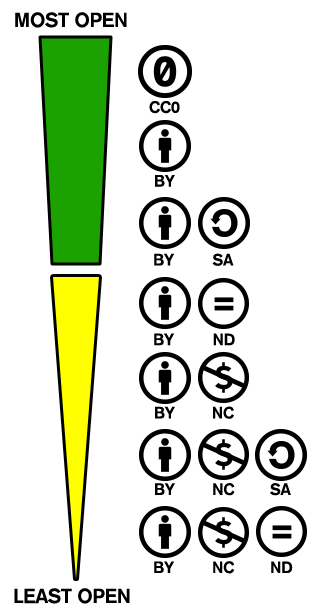
Creative Commons licenses provide a standard way for content creators to grant someone else permission to use their work. Their free, easy-to-use copyright licenses provide a simple, standardized way to give you permission to share and use your creative work— on conditions of your choice.
Authors may choose to publish with a Creative Commons license in any of the ASHA journals when they select an open access option. In addition, when an article is published, all supplemental material submitted by authors are deposited into ASHA journals’ Figshare open source data repository. Figshare uses Creative Commons licenses for supplemental materials hosted on their site. CC BY is the license used for most file types. CC0 is the standard license used for sharing data and databases. However, you can select another license to set access restrictions on your supplemental material if needed.
Creative Commons offers six different content licenses. The following describes each of the six main licenses offered when you choose to publish your work with a Creative Commons license. We have listed them starting with the most accommodating license type you can choose and ending with the most restrictive license type you can choose. The first step to sharing your work is to choose the conditions that you want to apply to your work, then select the license that’s right for you.

Steps to Picking a License
Step 1. Choose Conditions
Attribution

Credit must be given to the creator
ShareAlike

Adaptations must be shared under the same terms
NonCommercial

Only noncommercial uses of the work are permitted
NoDerivatives

No derivatives or adaptations of the work are permitted
Step 2. Select a License
Based on your choices, you can select a license that clearly indicates how other people may use your creative work.
Attribution
CCBY
CC BY: This license allows reusers to distribute, remix, adapt, and build upon the material in any medium or format, so long as attribution is given to the creator. The license allows for commercial use.
Attribution-ShareAlike
CCBY-SA
CC BY-SA: This license allows reusers to distribute, remix, adapt, and build upon the material in any medium or format, so long as attribution is given to the creator. The license allows for commercial use. If you remix, adapt, or build upon the material, you must license the modified material under identical terms.
Attribution-NonCommercial
CCBY-NC
CC BY-NC: This license allows reusers to distribute, remix, adapt, and build upon the material in any medium or format for noncommercial purposes only, and only so long as attribution is given to the creator.
Attribution-NonCommercial-ShareAlike
CCBY-NC-SA
CC BY-NC-SA: This license allows reusers to distribute, remix, adapt, and build upon the material in any medium or format for noncommercial purposes only, and only so long as attribution is given to the creator. If you remix, adapt, or build upon the material, you must license the modified material under identical terms.
Attribution-NoDerivs
CCBY-ND
CC BY-ND: This license allows reusers to copy and distribute the material in any medium or format in unadapted form only, and only so long as attribution is given to the creator. The license allows for commercial use.
Attribution-NonCommercial-NoDerivs
CCBY-NC-ND
CC BY-NC-ND: This license allows reusers to copy and distribute the material in any medium or format in unadapted form only, for noncommercial purposes only, and only so long as attribution is given to the creator.
Public Domain Tools
Creative Commons also provide tools that work in the “all rights granted” space of the public domain.
CC0
CC0 (aka CC Zero) is a public dedication tool, which allows creators to give up their copyright and put their works into the worldwide public domain. CC0 allows reusers to distribute, remix, adapt, and build upon the material in any medium or format, with no conditions.
Public Domain Mark (PDM)
The Public Domain Mark (PDM) allows any web user to “mark” a work as being in the public domain. The PDM is used to label works that are already free of known copyright restrictions.
What’s Eligible for a Creative Commons License?
Please understand that you may only submit a file to be published with a Creative Commons license if it consists entirely of content licensable by you under the CC BY license. Some examples of such licensable content are:
- Your originally created content
- Other content marked with a CC BY license
- Content in the public domain
Where Can I Find Out More About Creative Commons?
There is much more information, including a number of helpful videos about Creative Commons, on their Web site. For more information, please visit creativecommons.org
Except where otherwise noted, this work is licensed under http://creativecommons.org/licenses/by/4.0/


